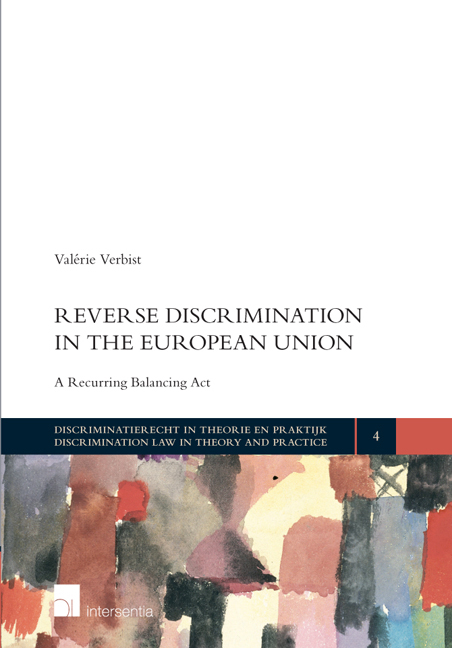Book contents
- Frontmatter
- Acknowledgements
- Contents
- Table of Cases of the European Court of Justice
- Chapter 1 Introduction
- Part I Reverse Discrimination from a Union Perspective
- Chapter 2 The European Court of Justice's Approach to Reverse Discrimination
- Chapter 3 Applicability and Interpretation of the Purely Internal Situation Doctrine
- Conclusion Part I
- Part II Reverse Discrimination from National Perspectives
- Part III Reverse Discrimination in a Federal State Context
- Bibliography
Conclusion Part I
from Part I - Reverse Discrimination from a Union Perspective
Published online by Cambridge University Press: 29 September 2018
- Frontmatter
- Acknowledgements
- Contents
- Table of Cases of the European Court of Justice
- Chapter 1 Introduction
- Part I Reverse Discrimination from a Union Perspective
- Chapter 2 The European Court of Justice's Approach to Reverse Discrimination
- Chapter 3 Applicability and Interpretation of the Purely Internal Situation Doctrine
- Conclusion Part I
- Part II Reverse Discrimination from National Perspectives
- Part III Reverse Discrimination in a Federal State Context
- Bibliography
Summary
REVERSE DISCRIMINATION AS A SIDE EFFECT OF THE SCOPE OF APPLICATION OF UNION LAW
According to settled case law of the ECJ, the Treaty provisions on free movement and citizenship do not apply to purely internal situations, in which all of the relevant aspects are confined to one single Member State. Therefore, a Member State may treat its own nationals in purely internal situations less favourably than persons falling within the scope of application of Union law. Hence, the limited scope of application of the Treaty provisions on free movement and citizenship may lead to a situation of reverse discrimination. In particular, reverse discrimination can be considered to be a side effect of the fact that national law and Union law are applicable to the same territory; however, each of them with its own limited scope of application.
It is settled case law of the Court of Justice that situations of reverse discrimination are not prohibited by Union law. Accordingly, situations of reverse discrimination fall within the scope of law of the Member States and they have to deal with it. It has been argued above that the ECJ's traditional approach remains valid since reverse discrimination has to be considered as a possible side effect of the limited scope of application of Union law which is based on the division of competences between the EU and the Member States as governed by the principle of conferral of powers.
It was argued that a general prohibition of reverse discrimination at Union level would only be possible by changing primary law; that is to say, by a Treaty amendment of the Treaty provisions on freedom of movement and Article 18 TFEU. However, this seems not only to be politically unfeasible in the near future, it also seems to be unnecessary and undesirable. First, the supposition that a general prohibition on reverse discrimination at Union level would lead to better protection of Union citizens in all cases has been challenged. The more favourable conditions for those who fall within the scope of Union law often impose fewer requirements in order to benefit from a certain right.
- Type
- Chapter
- Information
- Reverse Discrimination in the European UnionA Recurring Balancing Act, pp. 157 - 174Publisher: IntersentiaPrint publication year: 2017

